Ability to press effectively and disrupt Manchester City’s build-up is crucial to playing them in these games. Unless you’re willing to park the bus and keep things tight, you have to press to have any hope of ever getting the ball back and relieve pressure.
Especially when you start as sloppily as Arsenal did. Looked nervous, the crowd felt nervous. But Arsenal quickly shook that off on the ball and made adjustments off it.
Last season at the Etihad, the game was over before there was time to adjust to an unexpected gameplan. Arsenal went man-to-man, City dragged Partey forward and Gabriel had to leave the space ahead of him empty (and Kevin De Bruyne free) or fill the gap.
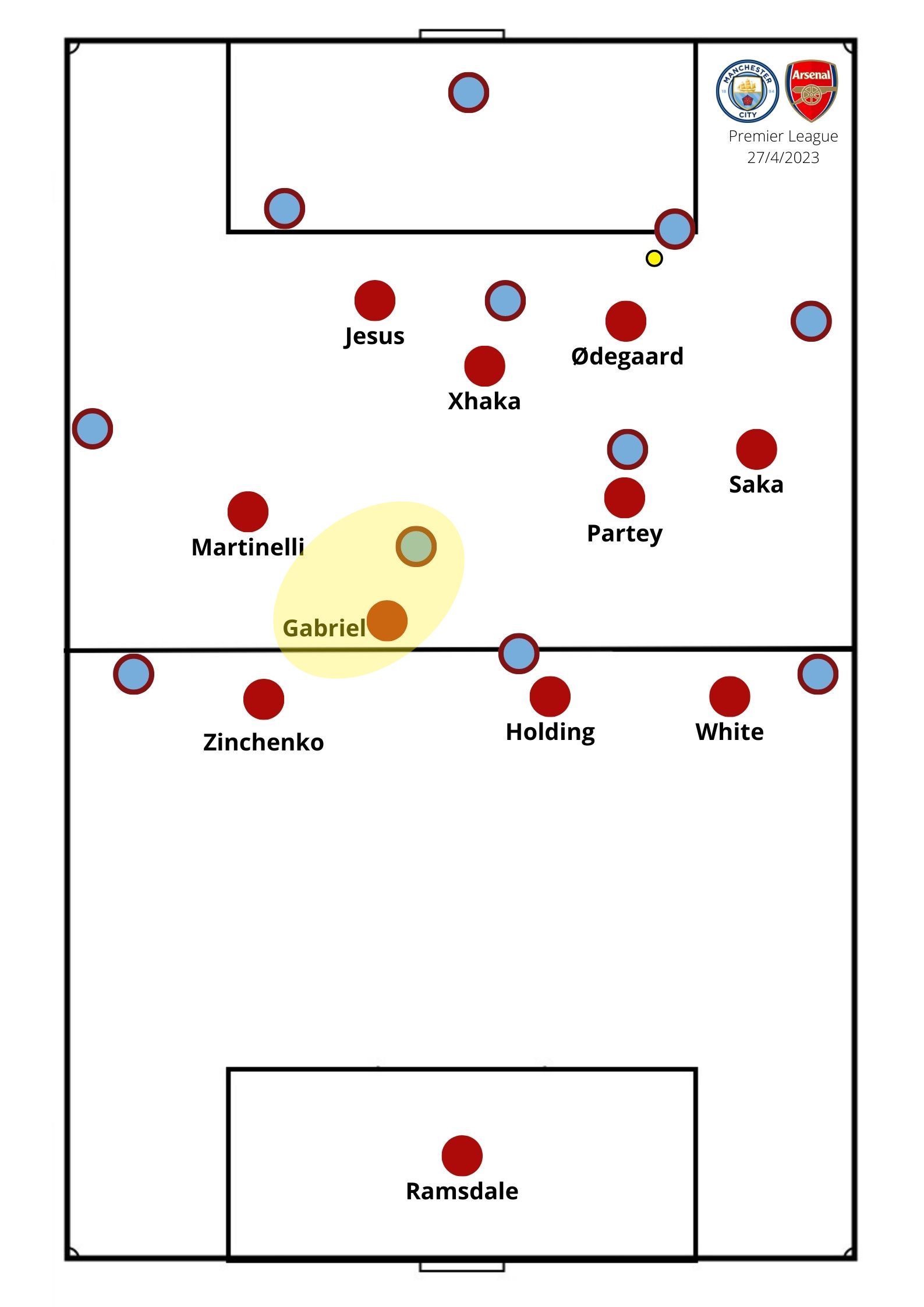 Arsenal were caught short as City went long to Erling Haaland and he combined with De Bruyne in the gaps in front of the defence before bursting into the space behind it.
Arsenal were caught short as City went long to Erling Haaland and he combined with De Bruyne in the gaps in front of the defence before bursting into the space behind it.
Pep Guardiola’s ability to make adjustments in-game is clearly something Mikel Arteta admires, as suggested in Friday’s press conference:
That’s a big quality of theirs because they can they can change it, but not only before the game, I think they can do it during the game, they can do it at half-time and that’s a strength of a team that is able to dominate.
Arteta’s own in-game changes often come too late in this fixture, or at times he has simply run out of answers as Guardiola keeps asking new questions, but not on Sunday. This time, it was Arteta with the changes and problem-solving that determined the match.
Early on, Arsenal went man-to-man again, but facing a City side without wingers made things much easier. To begin with, Gabriel Jesus pushed on to left-centre-back Nathan Ake as Arsenal looked to press with real intensity, following their direct counterparts around the pitch. The first issues with this approach were easy to see early on. Arsenal could put City under decent pressure but they were dragged upfield in doing so. Jesus closes down Ake and Ben White looks to close down the option to Josko Gvardiol at left-back.
The first issues with this approach were easy to see early on. Arsenal could put City under decent pressure but they were dragged upfield in doing so. Jesus closes down Ake and Ben White looks to close down the option to Josko Gvardiol at left-back.
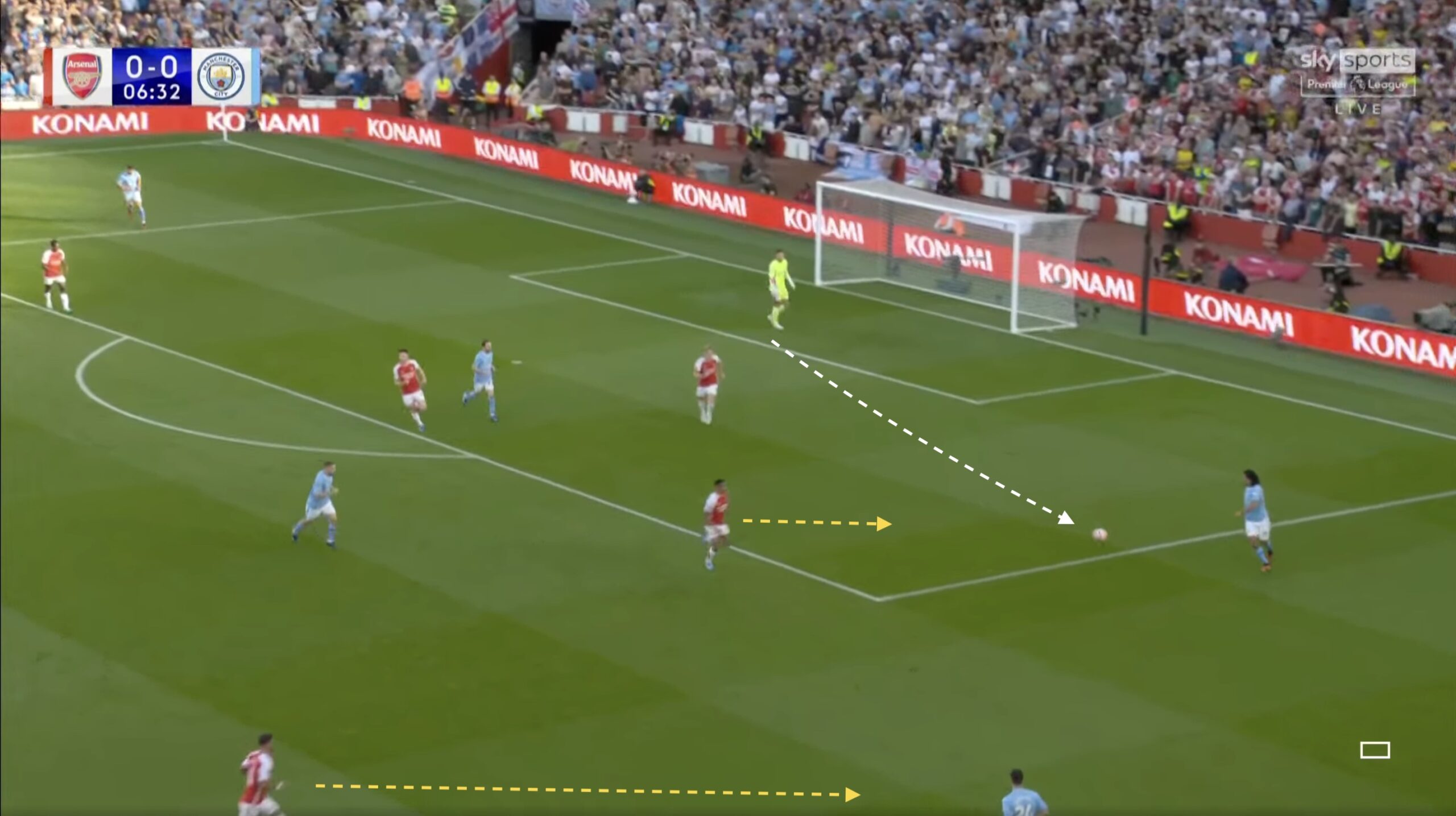
As more City players join to help, more Arsenal players follow and Jorginho is dragged into the press as is William Saliba, who follows Phil Foden in filling the space vacated by White.

This is fine against most opponents but not against City and Erling Haaland. Arsenal needed Saliba and Gabriel as a pair up against the Norwegian. But that alone was no fix. The next time the ball was forced into this same corner, Saliba was nowhere to be seen, sticking with Haaland alongside Gabriel, so Jorginho joined the press more aggressively instead, marking Kovacic as Martin Odegaard left him and being forced to chase Foden back as the ball was played down the line.

Arteta had a quick word as Jorginho collected his yellow card and, though the change wasn’t immediate, Arsenal shifted their press. Gabriel Jesus would no longer look after charging Ake down but marking Gvardiol instead. White was freed up to follow Foden, often into the middle of the pitch, in turn. Jorginho could work as cover for the midfielders up ahead of him and sweep up loose balls in front of the backline.
It was a more conservative approach, maybe, but it gave Arsenal a much more solid base, allowing them to cover Haaland with two defenders without allowing any easy progression upfield.
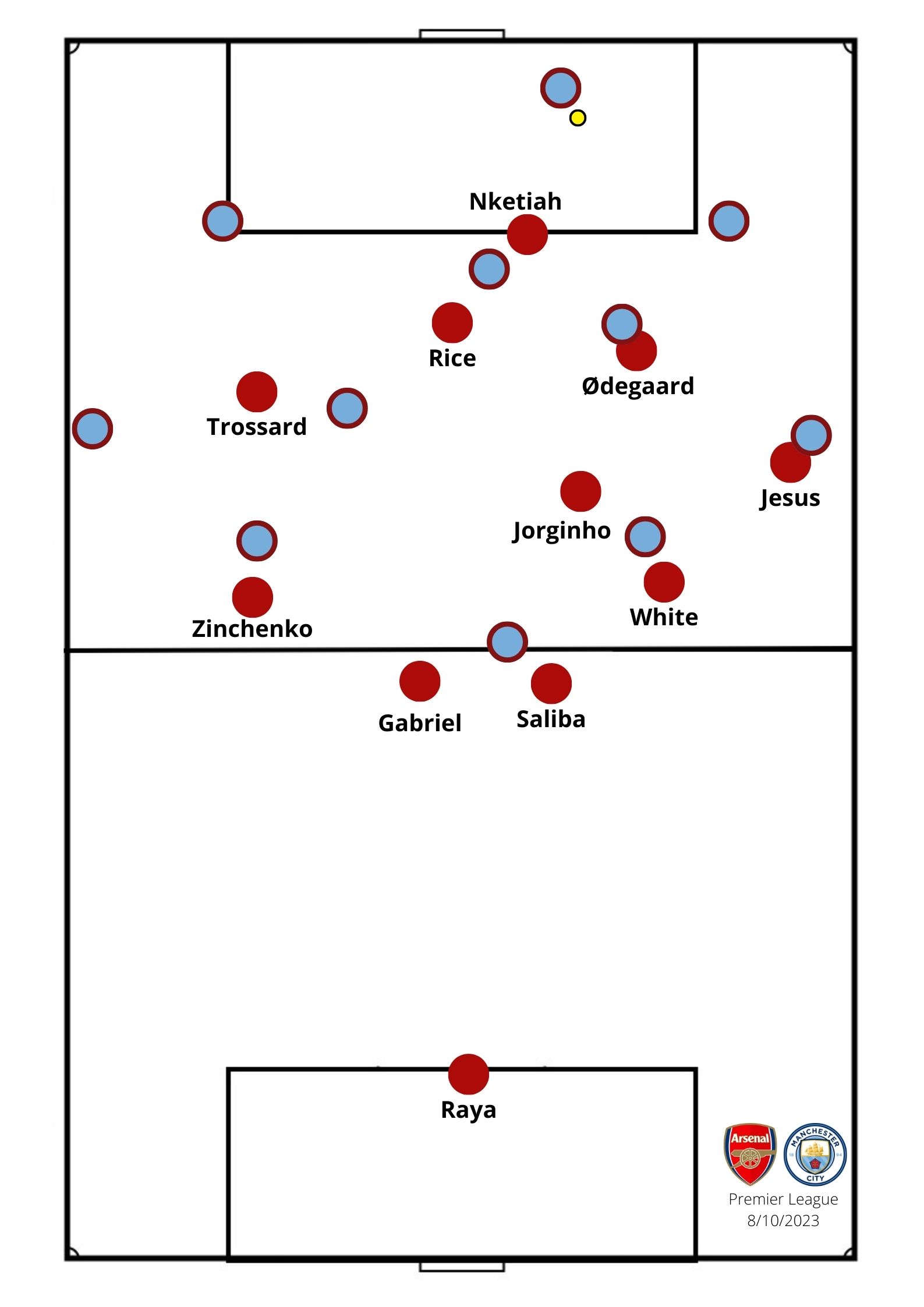 As City chose to play without any wingers there was no reason for White, and Zinchenko on the other side, not to follow Foden and Alvarez either side of Haaland.
As City chose to play without any wingers there was no reason for White, and Zinchenko on the other side, not to follow Foden and Alvarez either side of Haaland.
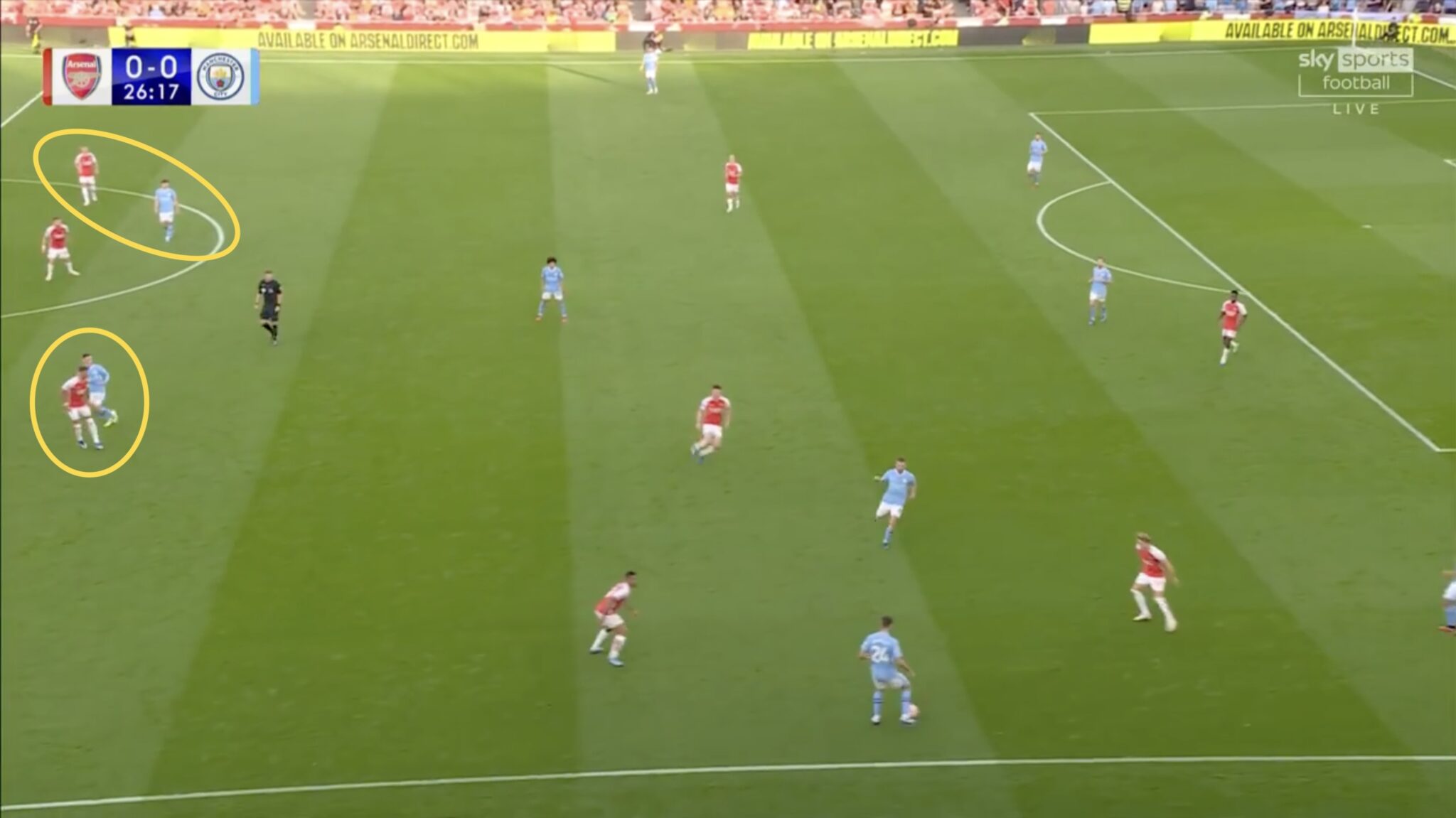
It was bizarre to see a Guardiola team opt not to pin the opposition fullbacks, especially with so much success doing just that in this fixture in the past. Kyle Walker has offered the width on the right this season, rather than playing like an extra centre-back, but he was conservative in his positioning and allowed Zinchenko’s task on that side to be kept relatively simple.
Likewise on the left, a true winger would have left White in two minds. Or simply with Foden on the touchline, Arsenal would have been stretched more easily and Jorginho would’ve been dragged into the press. That’s exactly what happened back in April. Still, even if the plan wasn’t great (or was too careful) from Guardiola, City take some beating. Arteta’s early adjustment helped Arsenal get a real foothold in the match and keep City at arm’s length: just 16% of their touches on Sunday came in the final third. That’s lower than in any Premier League match they have played in any of the last three seasons.
With the tight back four around Haaland and City’s two creative midfielders, Arsenal had a base to play from. The introduction of Gabriel Martinelli at half-time was timely, adding aggression with and without the ball.
Without possession, for all the hard work Leandro Trossard does get through, he doesn’t have the burst of pace (nor the engine) to cover two players as well as Martinelli does it. With the ball forced to City’s left, Trossard was often covering Rico Lewis in midfield before the break. The press was dialled up accordingly with Martinelli on the pitch, the Brazilian charging Dias down when possible but having the recovery pace to get himself back in position against Walker or — when needed — Lewis as well.
But it was in possession that Martinelli’s threat was most keenly felt. In possession Arsenal suddenly had a real direct, running threat on both flanks. If we talk about City not having the shape or the players to pin the Arsenal fullbacks, Arsenal absolutely had this at the other end of the pitch. The right flank served as a safe haven for possession — with Saliba, White, Jorginho, Odegaard and Jesus, this was clearly the side of the pitch where Arsenal could retain the ball. And they did, dragging City across so Martinelli (and Rice) had opportunities to run one-on-one at the other end. Generally Arsenal played it safe from the back throughout, looking to keep possession by outnumbering the press, and it was Martinelli’s introduction that added really threat and thrust on the left that had previously only existed on the right.
The result as the game went on was more ambitious football from Arsenal, which pushed City back and helped Arteta’s side play an increasing amount of the game in the final third. Jesus tucking inside, for example, keeps Gvardiol inside and opens space for White to overlap …
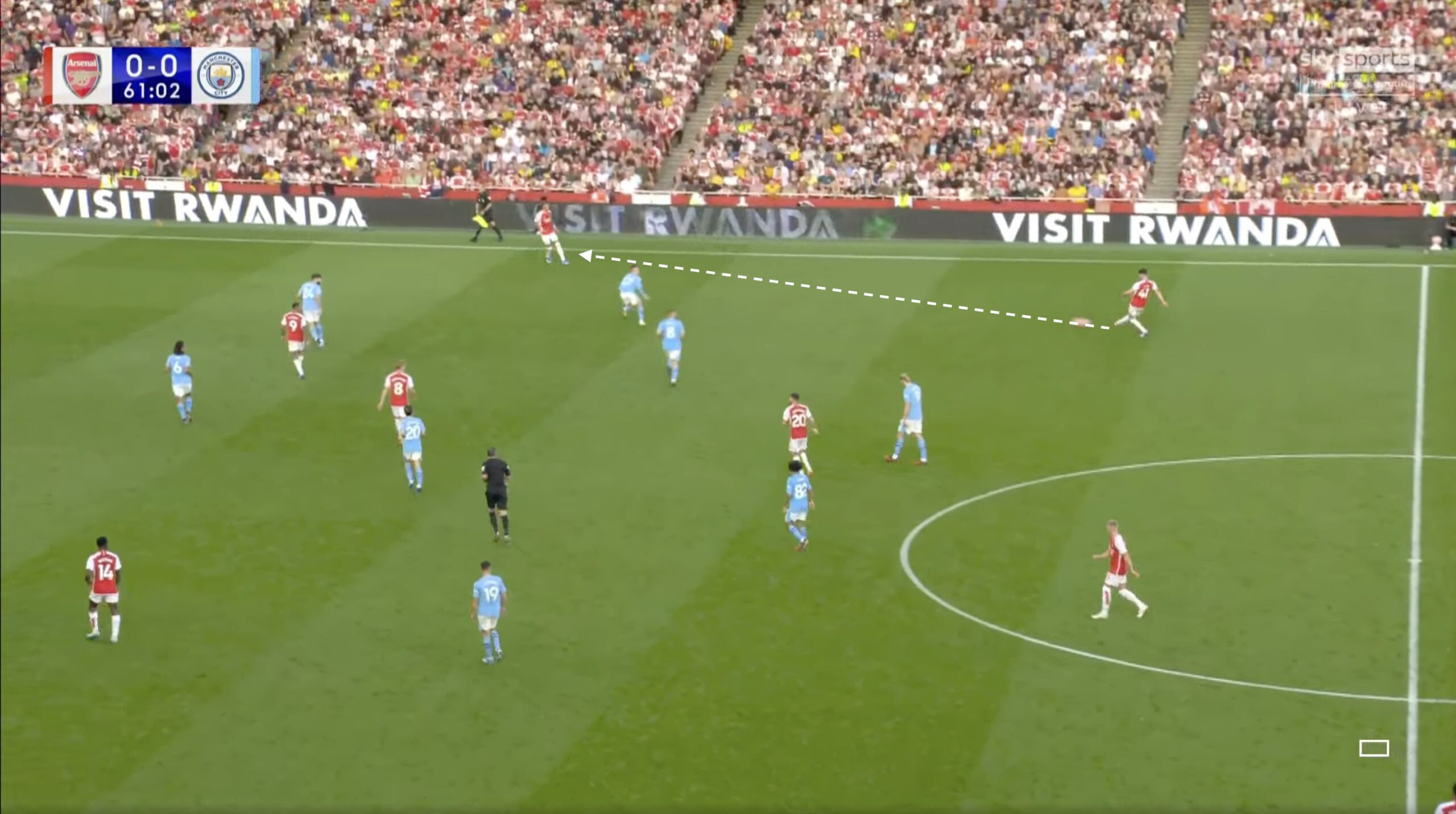
… with Gvardiol inside, Foden is forced to track back. A quick one-two on the Arsenal flank best suited for combination football drags Gvardiol out and Bernardo Silva rushes to fill the gap …
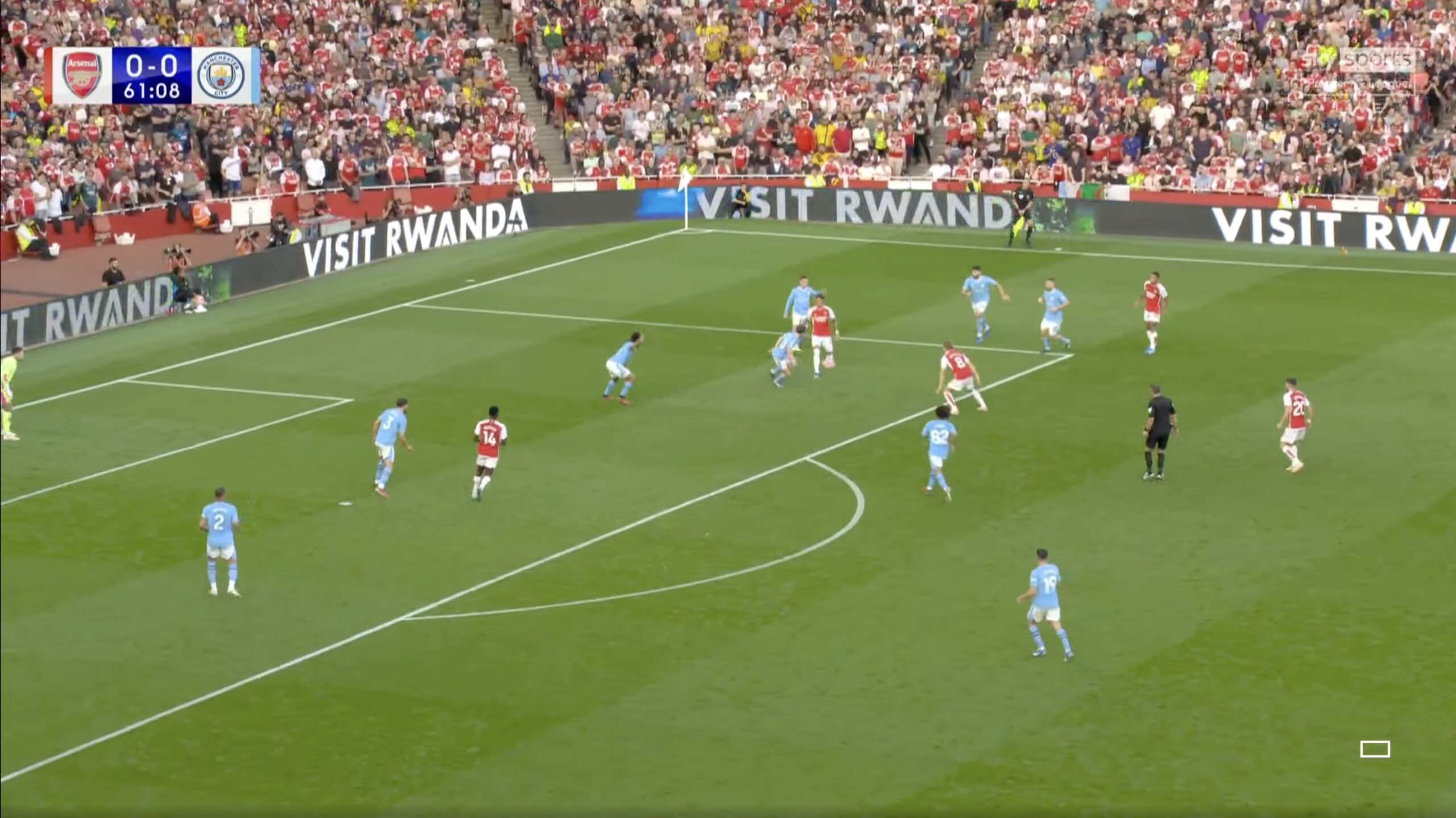
… and just like that, you could cover seven of City’s outfield players with a 20×25 metre tarpaulin and are all focused on the ball . One of the others is Haaland — miles away and not engaged at all defensively — while Walker has Martinelli over his shoulder. When the ball inevitably makes its way left, Alvarez rushes to prevent a one-on-one …
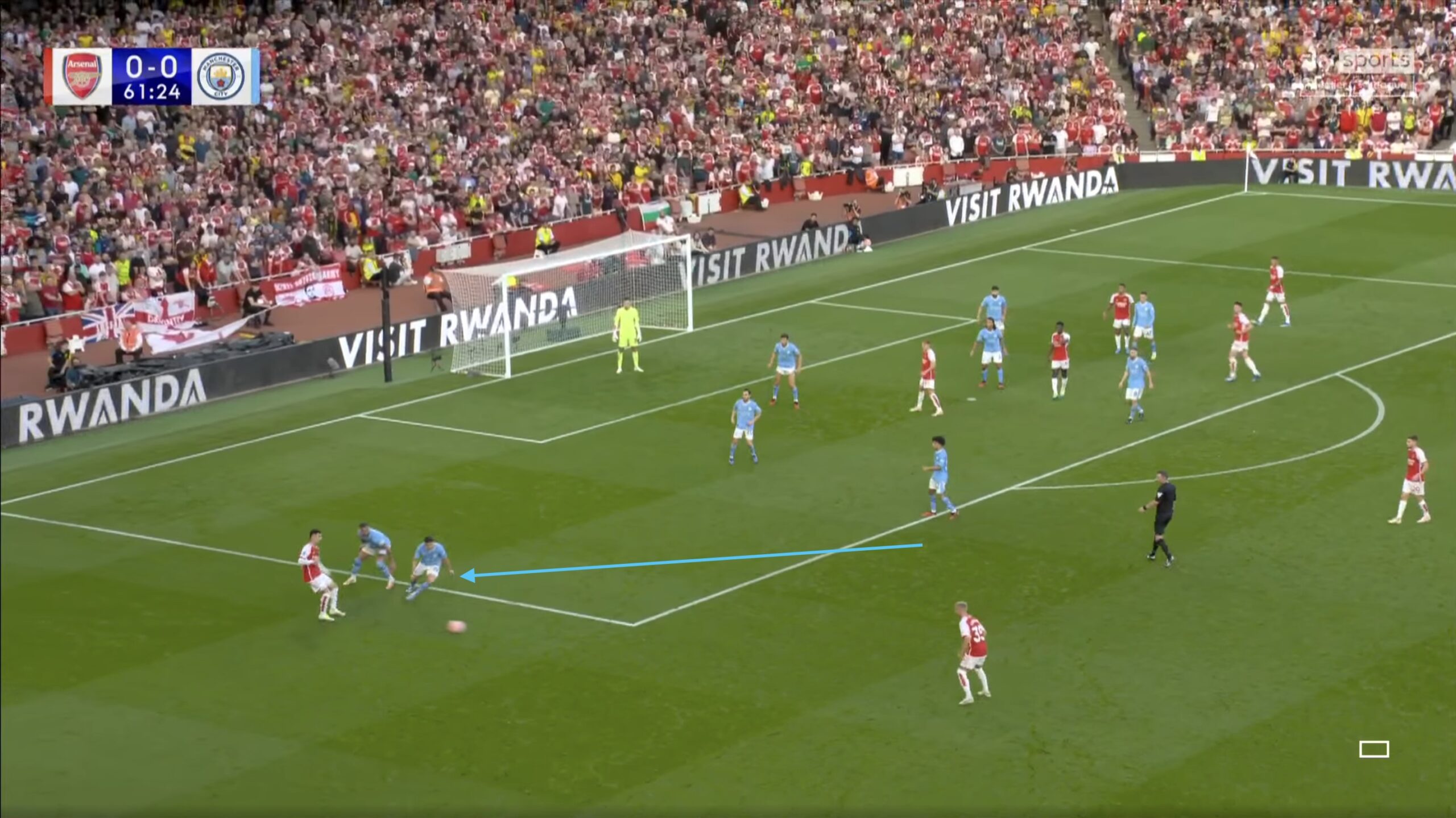
… leaving Zinchenko in acres to deliver a cross to the back post, where Arsenal have kept their previous overload despite the switch of play an outnumber City four to three when the cross comes in.
Overloading on the right continued after the subs, sometimes with a twist, like below where Martinelli comes in and it is Tomiyasu on the overlap up against Walker …
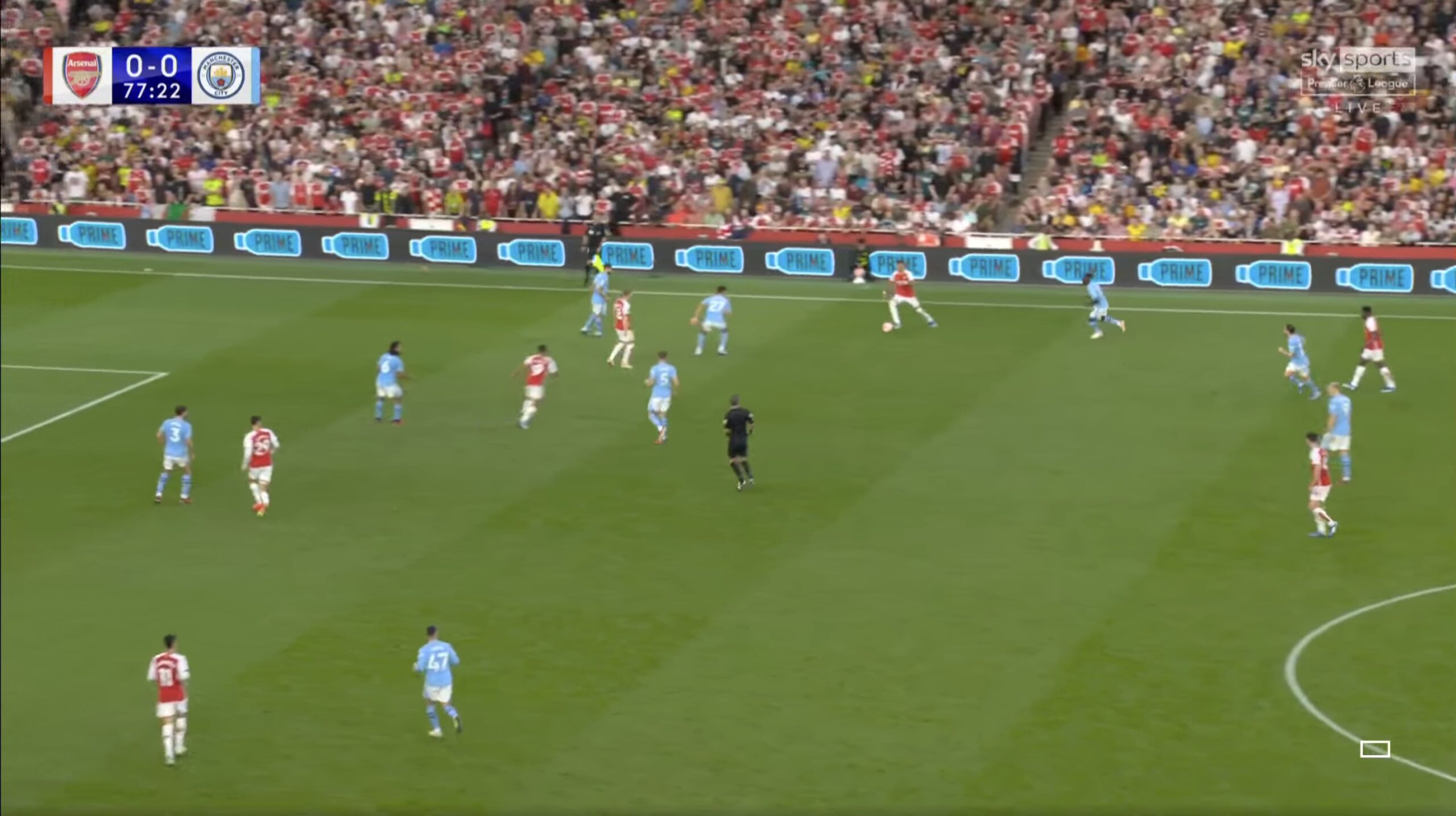
… and the introduction of Martinelli simply brought a balance to the flanks and a fear factor to the left that was crucial. This would not have carried the same impact without him.
When City did push forward with their wide players in a similar way, they did manage to get upfield and Arsenal defended well but had few opportunities to win the ball back without taking risks and leaving gaps. But Arsenal occupied and attacked the spaces better when they did it and there is no better example than the winning goal. Because this Manchester City possession looks remarkably similar.
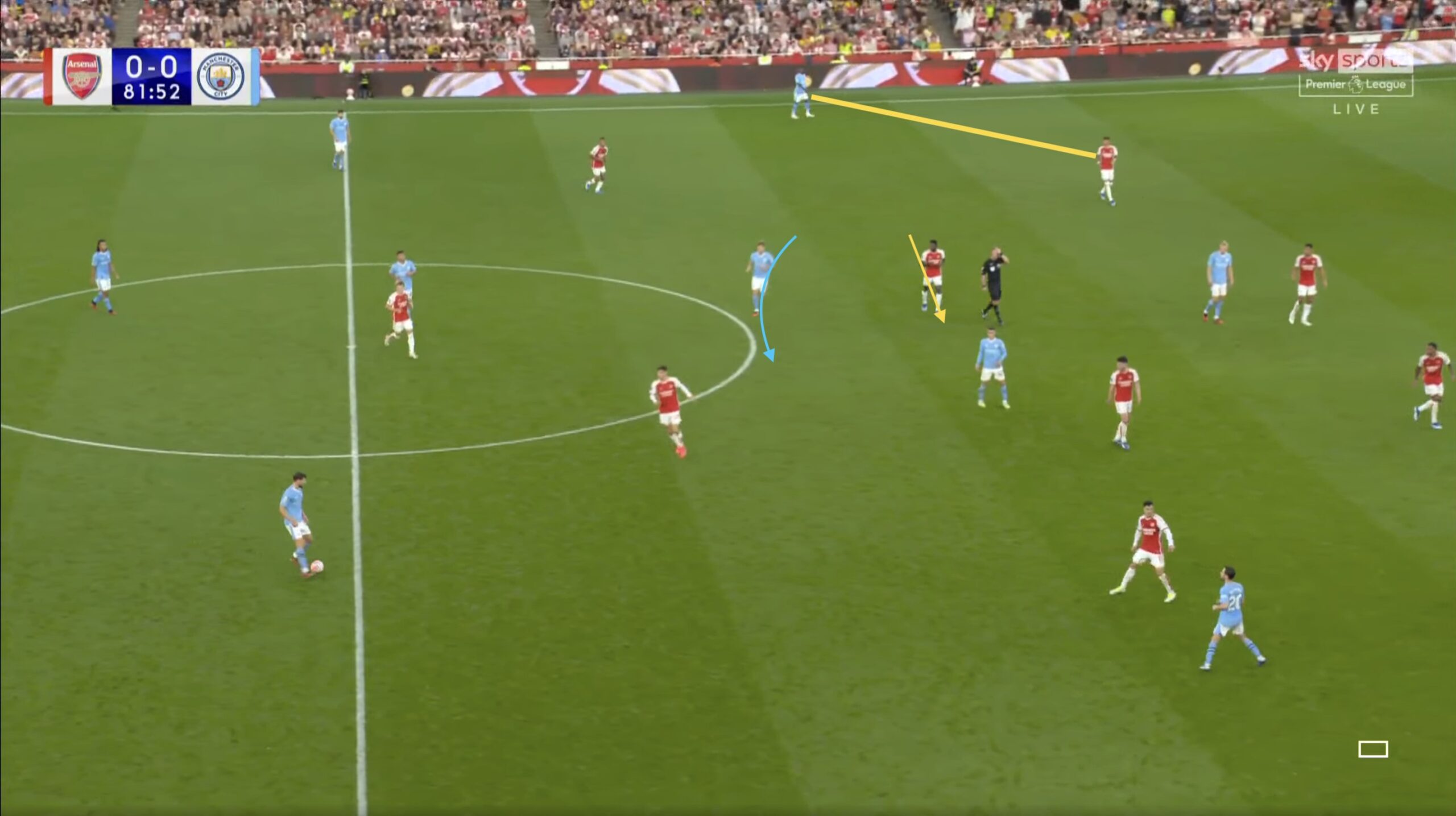
With Doku wide, White can’t tuck in. The gap to Saliba is growing. John Stones pulls Thomas Partey away from the area too as he drags across the pitch. And then nobody else moves. A run between White and Saliba from Gvardiol at left-back or Matheus Nunes in the centre circle would ask real questions of the Arsenal backline. White would have to leave it or tuck in and leave Doku free to receive the ball.
It is, really, the run we all recognise as one Granit Xhaka perfected over the course of last season. Now Matheus Nunes is not schooled in Guardiola’s ways just yet, and maybe City did not want to roll the dice and risk getting caught out, but movement here really could have hurt Arsenal. A lack of it made things easy.
Arsenal did not make the same mistake at the other end. With Martinelli out wide, Walker has the same issue White would have had. The only difference is, thanks to Takehiro Tomiyasu, the run actually does arrive.
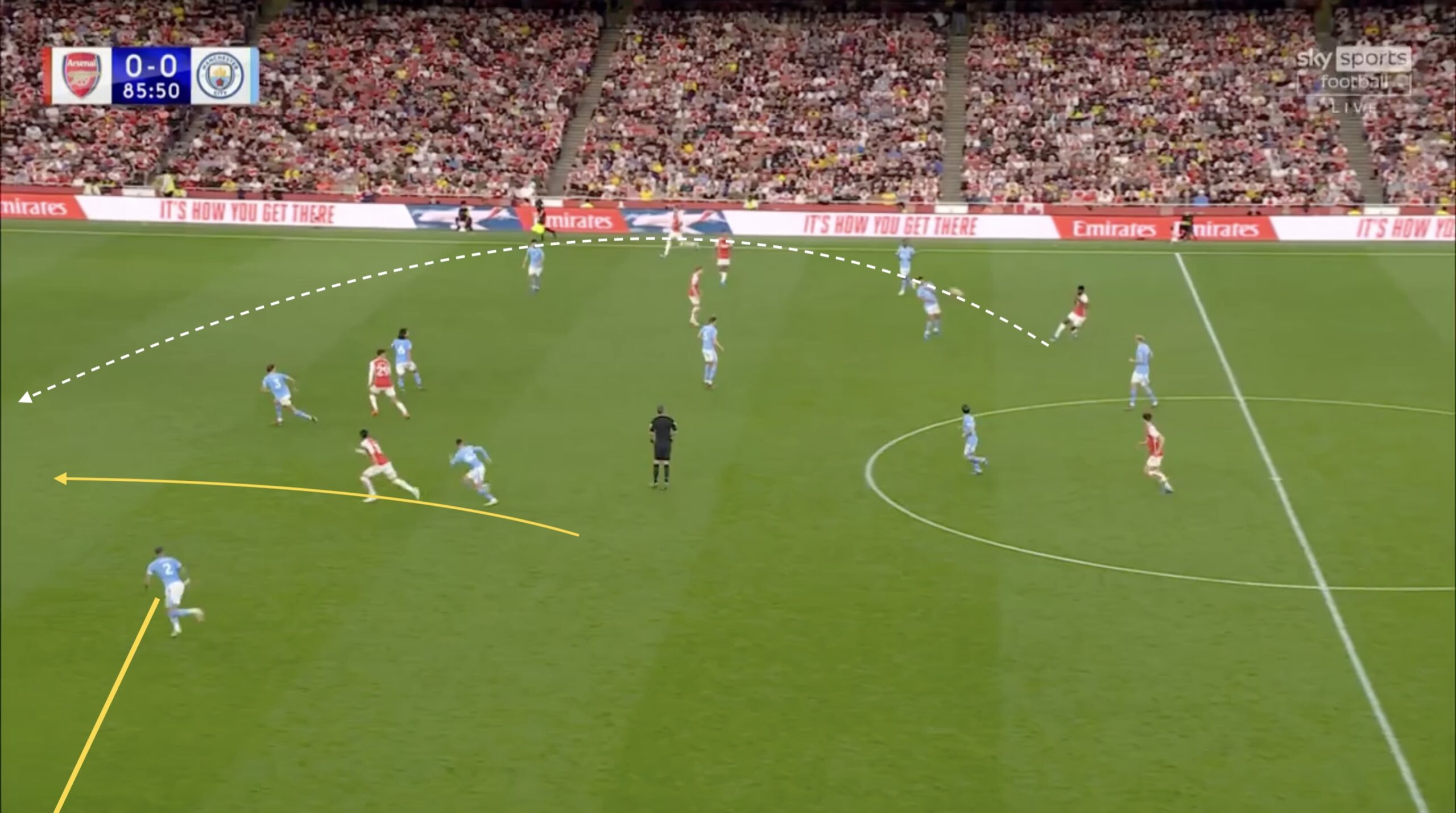
You all know what happened next.
Maybe Arsenal just wanted to force the issue more, at home and smelling the chance for a long overdue win against the champions, than the visitors. Ultimately, it felt like both sides were OK with a draw. But Arsenal were the team more willing to push for a win and they got exactly what they deserved.

